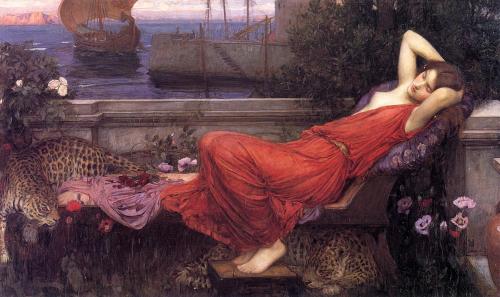#pre-raphaelite
Ariadne (1898), by J.W. Waterhouse
Another painting based on the 21 letters from Ovidius, collectively known under the name Heroides. The story of Ariadne is most renowned from her helping her beloved Theseus to kill the Minotaur and escape out of the labyrinth that her father had built. She did this by giving him a ball of thread so that he could find his way back. Here she is shown sleeping on a bench, while her lover is leaving her behind and sails away. The two panthers represent the god Dionysus who seduces her and makes her his wife.
In the Vatican Museum, there is a marble Hellenistic sculpture showing Ariadne in almost the same pose as on this painting. Waterhouse must have used it as a model. There are also obvious resemblances with the painting of Saint Cecilia (1895): the ship in the background, the balustrade separation and the sleeping woman to name just a few. In 1895, there was a large exhibition of Venetian art in London and its effect on his paintings is undeniable. Waterhouse becomes more and more influenced by the paintings of Botticelli and other works from the Italian Renaissance.
Post link

